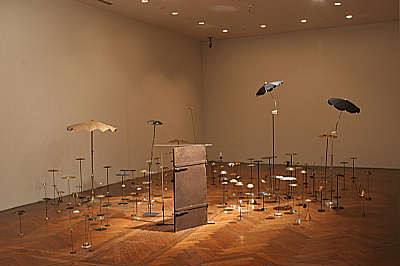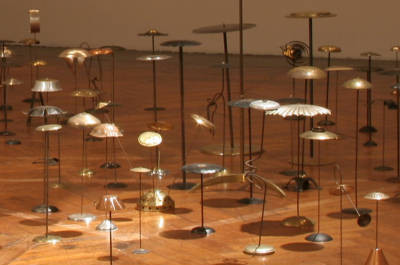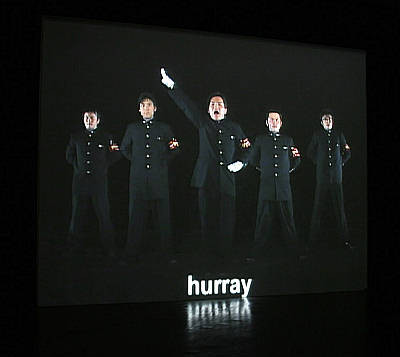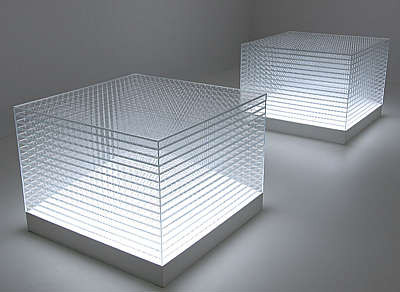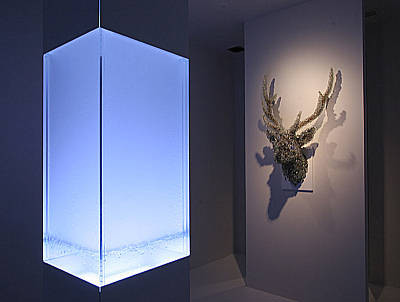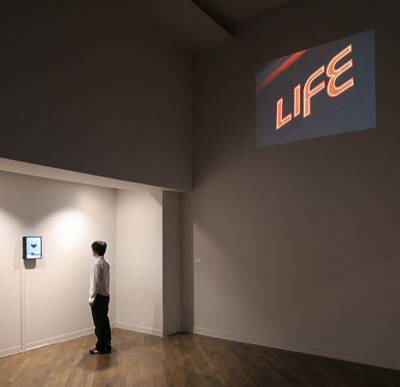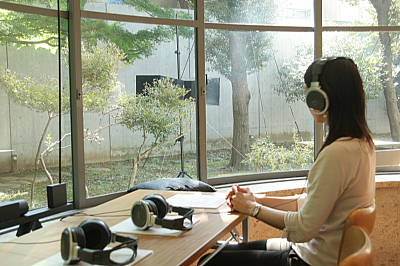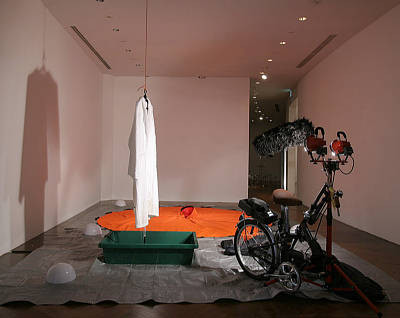Art Scope - Interface Complex
15 Jun - 02 Sep 2007
ART SCOPE - INTERFACE COMPLEX
Contemporary Art from Japan und Germany
15 June - 2 September 2007
Hiroharu Mori (J) · Kohei Nawa (J) · Katja Strunz (D) · Georg Winter (D)
Art Scope Daimler Japan is the name of a promotion program for young Japanese artists launched in 1991. In 2005, the award program was restructured to provide for an exchange of contemporary Japanese and German art.
The works of the four award winners in 2005 - Kohei Nawa and Hiroharu Mori from Japan, Katja Strunz and Georg Winter from Germany - were jointly presented in the fall of 2006, initially in the Hara Museum for Contemporary Art in Tokyo. For the second time after 2004, the works of the winners of the "Artist in Residence" award, a groundbreaking program for Japan, will also be shown in Haus Huth, Potsdamer Platz, Berlin. The exhibition comprises some 20 pictures, photographs, objects and installations part of which were specifically created for this project.
Kohei Nawa
The cervus nippon yesoensis, or Hokkaido sika deer, is an Eastern Asian deer species that now occurs in many areas of the world. In Germany too, a wild population of sika deer has developed since the mid 20th century, from animals that have escaped or been resettled. But Kohei Nawa did not find the sample he is exhibiting in Daimler Contemporary either in the Hokkaido area or in Germany.
Nawa starts his search with the well-known internet search engines, follows the electronic trail into online auction houses and finally acquires the desired item directly on screen - all on the World Wide Web. The artists then continues by covering the surface of his objects - from toys to shoes or musical instruments - completely with glass prisms and marbles. All the works created in this way for the so-called "PixCell" series do retain their original qualities, but they acquire a second skin - a "light envelope". In this way, Nawa shows his viewers to the particular qualities of the digital age and demonstrates how much the reality of things depends on perception.
All Kohei Nawa's works have a detectable tactile attraction inherent in them, as well as visual charm. Nawa's materials and techniques are always shaped by the particular forms of expression and material possibilities at the places where the artist is working. So the artist is broadening his scope for artistic expression in Berlin as well: he started to study the regularly changing graffiti outside his studio window and to compare them with the surface structure of his drawings as they emerged. Kohei Nawa took the awareness this gave him of his drawings' extraordinarily tactile component back to Japan with him. Nawa would like to become an artist who relates closely to locations, thoroughly familiar with the particular qualities of the world's great art cities.
Kohei Nawa was born in 1975 in Osaka in Japan. He lives and works in Kyoto.
Hiroharu Mori
Because he has spent so many years abroad, Hiroharu Mori has developed a sensitivity to intercultural differences and social interfaces. He discovers cultural and social 'abnormities' in this light, and then captures them successfully in his video works, usually bringing them out with some pointed humour.
Hiroharu Mori worked mainly in the medium of painting until the mid 1990s. Then, while studying in the USA, he started experimenting with simple video technology.
The video "After a Painting" reveals Mori's roots in that form: the apparently unchanging motif refers to Vermeer's 1658 "Milkmaid", using up-to-date video techniques to bring this painterly incarnation of 'stillness' into the present. All the features in the surrounding space are cut out. Mori concentrates instead on the only perceptible movement, pouring water, supported by the horizontal composition and his refined editing technique. The stillness and timelessness of the projected image draw an archetypal element out of this everyday action.
Mori conceived the video "Cheering for Art" on an Art Scope visit to Berlin. He observed the local art scene's practices on the spot, and was especially impressed by the apparent lack of inhibition shown by contemporary artists in Berlin, their enthusiasm and the excellent exhibition facilities at their disposal. This new background experience sharpened his view of the Japanese art world's idiosyncrasies when he returned to Japan. Mori engaged a group of student cheerleaders in Tokyo who agitated loudly about the merits of contemporary art in three rehearsed performances. The video tries to enthuse viewers about "the arts" in a strangely Japanese, almost military way, though behind all this is the element of "self-mockery" that is so deeply embedded in the Japanese mentality.
Hiroharu Mori, born in 1969, lives a works in Yokohoma, in the Kanagawa prefecture.
Katja Strunz
Katja Strunz's installation "Einladung zur Angst" [Invitation to Fear] contains exactly 132 small, unique figures, differing in height, diameter, material or treatment. The "figurines" are surreal-looking assemblages made of found objects and flea market acquisitions like reception bells, candelabras, ash-trays or metal bowl. A small iron door stands in the middle of the collection.
Summer flowers in a meadow, a wood full of mushrooms, or indeed a collection of Far Eastern percussion instruments - viewers can come up with a whole number of associations. Slowly and without noticing you are drawn into the artist's imagination, start reeling and forget yourself in the thicket of parasols. This idea of "invasion" by the viewer is one of the central themes of Katja Strunz's work. Her method is closely linked with the technique of "folding" that her well-known minimalist wall reliefs demonstrate in particular.
In "Einladung zur Angst", under the protection of the parasols, which have infolded as if in a dangerous situation, we are asked to find our way into the interface between concrete 'Gestalt' and abstraction. For Strunz, who is referring to Italo Calvino here, the abstract is light, immaterial and ideal - a weightless counterpart to the opaque density of this world. This eerie-seeming moment of letting to creates the temporal discontinuity that Katja Strunz's objects and installation try to capture, in order to unfold spatially again at the same mo-ment.
Katja Strunz, born in 1970, studied philosophy, art and graph-ics in Mainz and Karlsruhe. She lives and works in Berlin.
Georg Winter
On Shrove Monday 153 years ago Robert Schumann jumped into the Rhine near Düsseldorf, intending to end his life. But his attempted suicide was a pitiful failure. Schumann, wearing only his dressing-gown, was pulled out of the water by some Rhine boatmen, who recognized him and then taken home in proces-sion by a band of onlookers.
Georg Winter, during his visit to Tokyo, used this existential situation in the famous composer's life as a means of address-ing the contradictions posed by the German Romantics' nature Utopieas and urban conditions in modern Japan. Winter devel-oped his "Clara Schumann Radio Station" in the course of his Far Eastern research project. The radio station is a poetic ex-periment intended to enable viewers to experience the misun-derstandings that can arise as a result of failing to understand language and feelings.
For over 15 years, Winter has been the managing director controlling the fortunes of Ukiyo Camera Systems. UCS is a devel-opment office for camera technology and new media, and at the same time the umbrella organization for the artist's complex of artistic activities. The term "Ukiyo" comes from the Japanese and Winter translates it with this sentence: paying attention to the moment overcomes sadness about time slipping away.
In this sense, the Clara Schumann Radio Station is a logical further development for his creative work: Winter has been using temporary experimental set-ups and field research programmes to examine a whole variety of expressions relating to quality and values in the production of art and culture. Three-dimensional actions and processes are condensed in his conceptions, and opened to cognitive experience by re-applying experience to their existential fundamentals, relating to insight and condi-tioned by the body. Winter has developed a broad range of instruments for this under the banner of Ukiyo Camera Systems - cameras, notebooks, mobile phones and TV cameras, and uses them to extend conventional understanding of media terms by adding fundamental questions relating to social interaction, sensual and motor activity, and the correspondence between words and actions.
Georg Winter was born in Biberach in the Black Forest in 1962 and studied at the Staatliche Kunsthochule in Stuttgart. He lives and works in Stuttgart and Budapest.
Dr. Renate Wiehager, Head of Daimler Art Collection, Stuttgart/Berlin
ART SCOPE - INTERFACE COMPLEX
Zeitgenössische Kunst aus Japan und Deutschland
15. Juni - 2. September 2007
Hiroharu Mori (J) · Kohei Nawa (J) · Katja Strunz (D) · Georg Winter (D)
Art Scope Daimler Japan ist der Name eines 1991 begründeten Förderprogrammes für junge bildende Künstlerinnen und Künstler in Japan. 2005 wurde der Preis im Sinne eines Austausches japanischer und deutscher zeitgenössischer Kunst neu organisiert.
Die vier Preisträger des Jahres 2005 - Kohei Nawa und Hiroharu Mori aus Japan, Katja Strunz und Georg Winter aus Deutschland - wurden im Herbst 2006 zunächst im Hara Museum for Contemporary Art in Tokyo gemeinsam vorgestellt. Die Ausstellung zeigt rund 20 Bilder, Fotografien, Objekte und Installationen, die zum Teil spezifisch für dieses Projekt entstanden sind.
Kohei Nawa
Das cervus nippon yesoensis, oder Hokkaido-Sikahirsch, ist eine aus Ostasien stammende Hirschart, die heute in vielen Gegenden der Welt vorkommt. Auch in Deutschland hat sich seit Mitte des 20. Jahrhunderts aus entflohenen und umgesiedelten Tieren eine wild lebende Population von Sikahirschen entwickelt. Kohei Nawa hat sein im Daimler Contemporary ausgestelltes Exemplar weder in der Hokkaido-Region noch in Deutschland gefunden.
Nawa beginnt seine Suche in den wohlbekannten Internet-Suchmaschinen, verfolgt die elektronischen Spuren bis in die Online Auktionshäuser und erwirbt schließlich den gewünschten Artikel direkt am Bildschirm - alles im World Wide Web. Bei der sich anschließenden Bearbeitung bedeckt der Künstler die Oberfläche seiner Objekte - von Spielzeugen bis hin zu Schuhen oder Musikinstrumenten - gänzlich mit Glasprismen und Glasmurmeln. Sämtliche auf diese Weise entstandenen Werke der so genannten "PixCell"- Serie bewahren zwar ihre ursprüngliche Eigenschaft, jedoch erhalten sie eine zweite Haut - eine "Lichthülle". Auf diese Weise bringt Nawa dem Betrachter die Besonderheiten des digitalen Zeitalters nahe und belegt, wie sehr die Realität der Dinge von deren Wahrnehmung abhängt.
Nawas Materialien und Techniken sind stets durch die kulturellen Ausdrucksformen und die materiellen Möglichkeiten geprägt, die mit seinem jeweiligen Arbeitsort verbunden sind. So erweiterte der Künstler auch in Berlin seine persönlichen Ausdrucksmöglichkeiten: Vor Ort begann der Künstler, die regelmäßig vor seinem Studiofenster wechselnden Graffitis zu studieren und mit der Oberflächenstruktur seiner entstehenden Zeichnungen zu vergleichen. Das dabei entstandene Bewusstsein für die außergewöhnlich haptische Komponente seiner Zeichnungen nahm Kohei Nawa mit zurück nach Japan.
Kohei Nawa wurde 1975 in Osaka in Japan geboren. Er lebt und arbeitet in Kioto.
Hiroharu Mori
Hiroharu Mori hat, aufgrund seiner langjährigen Auslandsaufenthalte, eine Sensibilität für interkulturelle Unterschiede und gesellschaftliche Schnittstellen entwickelt. Aus dieser Perspektive entdeckt er kulturelle und soziale ‚Abnormitäten', die es ihm gelingt einzufangen und, meist humorvoll, in seinen Videoarbeiten pointiert herauszustellen.
In dem Video "After a Painting" offenbaren sich Moris Wurzeln in der Malerei: Das scheinbar unveränderliche Motiv verweist auf Vermeers "Milchmagd" aus dem Jahr 1658 und überführt diese malerische Inkarnation der ‚Stille' mittels zeitgemäßer Videotechnik in die Jetztzeit. Alle räumlichen Gegebenheiten werden ausgeblendet zugunsten der Konzentration, unterstützt durch die horizontale Komposition und eine perfektionierte Schnitttechnik, auf die allein wahrnehmbare Bewegung des Ausschenkens von Wasser. Stille und Zeitlosigkeit des projizierten Bildes lassen in der alltäglichen Handlung ein archetypisches Moment aufscheinen.
Das Video "Cheering for Art" hat Mori während eines Art Scope-Aufenthaltes in Berlin konzipiert. Vor Ort beobachtete der Künstler die Gepflogenheiten in der lokalen Kunstszene und war insbesondere von der scheinbaren Zwanglosigkeit, der Begeisterung und den exzellenten Ausstellungsmöglichkeiten beeindruckt, die sich für zeitgenössische Künstler in Berlin bieten. Zurück in Japan schärfte dieser neuer Erfahrungshintergrund seine Wahrnehmung für die Eigenarten der japanischen Kunstwelt. Mori engagierte in Tokyo eine Gruppe von studentischen Cheerleadern, die in drei einstudierten Performances die Vorzüge der zeitgenössischen Kunst lautstark agitieren. Das Video versucht den Betrachter auf eigentümlich japanische, fast militärische Art und Weise für die "Künste" aufzumuntern. Dahinter allerdings steht das tief in der japanischen Mentalität verankerte Moment des "Sich-Selbst-Verspottens".
Hiroharu Mori, 1969 geboren, lebt und arbeitet in Yokohama, in der Präfektur Kanagawa.
Katja Strunz
Sommerblumen auf einer Wiese, ein Wald voller Pilze, oder doch eine Sammlung fernöstlicher Schlaginstrumente - die Assoziationsmöglichkeiten für den Betrachter sind mannigfaltig. Langsam und ohne es zu merken wird man in die Phantasie der Künstlerin hineingezogen, gerät ins Taumeln und vergisst sich im Dickicht der Parasols. Diese Idee der "Invasion" ist ein zentrales Thema der Skulpturen, Objekte und Installationen von Katja Strunz. Ihre Arbeitsweise ist eng verbunden mit der Technik des "Faltens", erkennbar insbesondere in ihren minimalistischen Wandreliefs.
In "Einladung zur Angst" werden wir aufgefordert, die sich wie in einer Gefahrensituation entfaltet haben, uns gedanklich im Schutz der Parasols an der Schnittstelle von konkreter ‚Gestalt" und Abstraktion einzufinden. Das Abstrakte ist für Strunz, die sich hier auf Italo Calvino bezieht, das Leichte, Immaterielle und Ideelle - ein schwereloses Gegenstück zur opaken Dichtigkeit dieser Welt. In diesem unheimlich anmutenden Moment des Loslassens entsteht die zeitliche Diskontinuität, welche die Objekte und Installationen von Katja Strunz einzufangen versuchen, um sich im gleichen Moment räumlich wieder zu entfalten.
Katja Strunz, Jahrgang 1970, studierte in Mainz und Karlsruhe Philosophie, Kunst und Grafik. Sie lebt und arbeitet in Berlin.
Georg Winter
Am Rosenmontag vor 153 Jahren sprang Robert Schumann, in der Absicht seinem Leben ein Ende zu setzen, in den Rhein bei Düsseldorf. Der Selbstmordversuch misslang jedoch kläglich. Schumann, nur im Morgenmantel gekleidet, wurde von Rheinschiffern, die ihn erkannten, aus dem Wasser gezogen und anschließend von einer Horde Schaulustiger mit einer Maskerade nach Hause geleitet.
Diese existenzielle Situation des bekannten deutschen Komponisten nahm Georg Winter während seines Tokio-Aufenthaltes zum Anlass, sich mit den Widersprüchen der Natur-Utopien deutscher Romantiker und den heutigen urbanen Gegebenheiten in Japan auseinanderzusetzen. Winter entwickelte im Rahmen seines fernöstlichen Forschungsprojektes die "Clara Schumann Radio Station".
Seit mehr als 15 Jahren leitet Winter, als geschäftsführender Direktor, die Geschicke von Ukiyo Camera Systems. UCS ist ein Entwicklungsbüro für Kameratechnik und neue Medien und zugleich die Dachorganisation, unter der die komplex verzweigten künstlerischen Aktivitäten des Künstlers zusammengefasst werden. Den aus dem Japanischen stammenden Begriff "Ukiyo" übersetzt Winter mit dem Satz: Die Achtsamkeit für den Augenblick überwindet die Traurigkeit vor dem Verrinnen der Zeit.
Winter hat dafür, unter der Firmierung von Ukiyo Camera Systems, eine breite Palette von Instrumentarien entwickelt - Fotokameras, Notebooks, Mobiltelefonen oder TV-Kameras -, die in der Anwendung das konventionelle Verständnis von Medienbegriffen um grundlegende Fragen der sozialen Interaktion, sinnlich-motorischer Aktivitäten und der Entsprechung von Wort und Handlung erweitern.
Georg Winter, geboren 1962 in Biberach im Schwarzwald, hat an der Staatlichen Kunsthochschule Stuttgart studiert. Er lebt und arbeitet in Stuttgart und Budapest.
Dr. Renate Wiehager, Leiterin der Daimler Kunst Sammlung, Stuttgart/Berlin
www.sammlung.daimler.com
Contemporary Art from Japan und Germany
15 June - 2 September 2007
Hiroharu Mori (J) · Kohei Nawa (J) · Katja Strunz (D) · Georg Winter (D)
Art Scope Daimler Japan is the name of a promotion program for young Japanese artists launched in 1991. In 2005, the award program was restructured to provide for an exchange of contemporary Japanese and German art.
The works of the four award winners in 2005 - Kohei Nawa and Hiroharu Mori from Japan, Katja Strunz and Georg Winter from Germany - were jointly presented in the fall of 2006, initially in the Hara Museum for Contemporary Art in Tokyo. For the second time after 2004, the works of the winners of the "Artist in Residence" award, a groundbreaking program for Japan, will also be shown in Haus Huth, Potsdamer Platz, Berlin. The exhibition comprises some 20 pictures, photographs, objects and installations part of which were specifically created for this project.
Kohei Nawa
The cervus nippon yesoensis, or Hokkaido sika deer, is an Eastern Asian deer species that now occurs in many areas of the world. In Germany too, a wild population of sika deer has developed since the mid 20th century, from animals that have escaped or been resettled. But Kohei Nawa did not find the sample he is exhibiting in Daimler Contemporary either in the Hokkaido area or in Germany.
Nawa starts his search with the well-known internet search engines, follows the electronic trail into online auction houses and finally acquires the desired item directly on screen - all on the World Wide Web. The artists then continues by covering the surface of his objects - from toys to shoes or musical instruments - completely with glass prisms and marbles. All the works created in this way for the so-called "PixCell" series do retain their original qualities, but they acquire a second skin - a "light envelope". In this way, Nawa shows his viewers to the particular qualities of the digital age and demonstrates how much the reality of things depends on perception.
All Kohei Nawa's works have a detectable tactile attraction inherent in them, as well as visual charm. Nawa's materials and techniques are always shaped by the particular forms of expression and material possibilities at the places where the artist is working. So the artist is broadening his scope for artistic expression in Berlin as well: he started to study the regularly changing graffiti outside his studio window and to compare them with the surface structure of his drawings as they emerged. Kohei Nawa took the awareness this gave him of his drawings' extraordinarily tactile component back to Japan with him. Nawa would like to become an artist who relates closely to locations, thoroughly familiar with the particular qualities of the world's great art cities.
Kohei Nawa was born in 1975 in Osaka in Japan. He lives and works in Kyoto.
Hiroharu Mori
Because he has spent so many years abroad, Hiroharu Mori has developed a sensitivity to intercultural differences and social interfaces. He discovers cultural and social 'abnormities' in this light, and then captures them successfully in his video works, usually bringing them out with some pointed humour.
Hiroharu Mori worked mainly in the medium of painting until the mid 1990s. Then, while studying in the USA, he started experimenting with simple video technology.
The video "After a Painting" reveals Mori's roots in that form: the apparently unchanging motif refers to Vermeer's 1658 "Milkmaid", using up-to-date video techniques to bring this painterly incarnation of 'stillness' into the present. All the features in the surrounding space are cut out. Mori concentrates instead on the only perceptible movement, pouring water, supported by the horizontal composition and his refined editing technique. The stillness and timelessness of the projected image draw an archetypal element out of this everyday action.
Mori conceived the video "Cheering for Art" on an Art Scope visit to Berlin. He observed the local art scene's practices on the spot, and was especially impressed by the apparent lack of inhibition shown by contemporary artists in Berlin, their enthusiasm and the excellent exhibition facilities at their disposal. This new background experience sharpened his view of the Japanese art world's idiosyncrasies when he returned to Japan. Mori engaged a group of student cheerleaders in Tokyo who agitated loudly about the merits of contemporary art in three rehearsed performances. The video tries to enthuse viewers about "the arts" in a strangely Japanese, almost military way, though behind all this is the element of "self-mockery" that is so deeply embedded in the Japanese mentality.
Hiroharu Mori, born in 1969, lives a works in Yokohoma, in the Kanagawa prefecture.
Katja Strunz
Katja Strunz's installation "Einladung zur Angst" [Invitation to Fear] contains exactly 132 small, unique figures, differing in height, diameter, material or treatment. The "figurines" are surreal-looking assemblages made of found objects and flea market acquisitions like reception bells, candelabras, ash-trays or metal bowl. A small iron door stands in the middle of the collection.
Summer flowers in a meadow, a wood full of mushrooms, or indeed a collection of Far Eastern percussion instruments - viewers can come up with a whole number of associations. Slowly and without noticing you are drawn into the artist's imagination, start reeling and forget yourself in the thicket of parasols. This idea of "invasion" by the viewer is one of the central themes of Katja Strunz's work. Her method is closely linked with the technique of "folding" that her well-known minimalist wall reliefs demonstrate in particular.
In "Einladung zur Angst", under the protection of the parasols, which have infolded as if in a dangerous situation, we are asked to find our way into the interface between concrete 'Gestalt' and abstraction. For Strunz, who is referring to Italo Calvino here, the abstract is light, immaterial and ideal - a weightless counterpart to the opaque density of this world. This eerie-seeming moment of letting to creates the temporal discontinuity that Katja Strunz's objects and installation try to capture, in order to unfold spatially again at the same mo-ment.
Katja Strunz, born in 1970, studied philosophy, art and graph-ics in Mainz and Karlsruhe. She lives and works in Berlin.
Georg Winter
On Shrove Monday 153 years ago Robert Schumann jumped into the Rhine near Düsseldorf, intending to end his life. But his attempted suicide was a pitiful failure. Schumann, wearing only his dressing-gown, was pulled out of the water by some Rhine boatmen, who recognized him and then taken home in proces-sion by a band of onlookers.
Georg Winter, during his visit to Tokyo, used this existential situation in the famous composer's life as a means of address-ing the contradictions posed by the German Romantics' nature Utopieas and urban conditions in modern Japan. Winter devel-oped his "Clara Schumann Radio Station" in the course of his Far Eastern research project. The radio station is a poetic ex-periment intended to enable viewers to experience the misun-derstandings that can arise as a result of failing to understand language and feelings.
For over 15 years, Winter has been the managing director controlling the fortunes of Ukiyo Camera Systems. UCS is a devel-opment office for camera technology and new media, and at the same time the umbrella organization for the artist's complex of artistic activities. The term "Ukiyo" comes from the Japanese and Winter translates it with this sentence: paying attention to the moment overcomes sadness about time slipping away.
In this sense, the Clara Schumann Radio Station is a logical further development for his creative work: Winter has been using temporary experimental set-ups and field research programmes to examine a whole variety of expressions relating to quality and values in the production of art and culture. Three-dimensional actions and processes are condensed in his conceptions, and opened to cognitive experience by re-applying experience to their existential fundamentals, relating to insight and condi-tioned by the body. Winter has developed a broad range of instruments for this under the banner of Ukiyo Camera Systems - cameras, notebooks, mobile phones and TV cameras, and uses them to extend conventional understanding of media terms by adding fundamental questions relating to social interaction, sensual and motor activity, and the correspondence between words and actions.
Georg Winter was born in Biberach in the Black Forest in 1962 and studied at the Staatliche Kunsthochule in Stuttgart. He lives and works in Stuttgart and Budapest.
Dr. Renate Wiehager, Head of Daimler Art Collection, Stuttgart/Berlin
ART SCOPE - INTERFACE COMPLEX
Zeitgenössische Kunst aus Japan und Deutschland
15. Juni - 2. September 2007
Hiroharu Mori (J) · Kohei Nawa (J) · Katja Strunz (D) · Georg Winter (D)
Art Scope Daimler Japan ist der Name eines 1991 begründeten Förderprogrammes für junge bildende Künstlerinnen und Künstler in Japan. 2005 wurde der Preis im Sinne eines Austausches japanischer und deutscher zeitgenössischer Kunst neu organisiert.
Die vier Preisträger des Jahres 2005 - Kohei Nawa und Hiroharu Mori aus Japan, Katja Strunz und Georg Winter aus Deutschland - wurden im Herbst 2006 zunächst im Hara Museum for Contemporary Art in Tokyo gemeinsam vorgestellt. Die Ausstellung zeigt rund 20 Bilder, Fotografien, Objekte und Installationen, die zum Teil spezifisch für dieses Projekt entstanden sind.
Kohei Nawa
Das cervus nippon yesoensis, oder Hokkaido-Sikahirsch, ist eine aus Ostasien stammende Hirschart, die heute in vielen Gegenden der Welt vorkommt. Auch in Deutschland hat sich seit Mitte des 20. Jahrhunderts aus entflohenen und umgesiedelten Tieren eine wild lebende Population von Sikahirschen entwickelt. Kohei Nawa hat sein im Daimler Contemporary ausgestelltes Exemplar weder in der Hokkaido-Region noch in Deutschland gefunden.
Nawa beginnt seine Suche in den wohlbekannten Internet-Suchmaschinen, verfolgt die elektronischen Spuren bis in die Online Auktionshäuser und erwirbt schließlich den gewünschten Artikel direkt am Bildschirm - alles im World Wide Web. Bei der sich anschließenden Bearbeitung bedeckt der Künstler die Oberfläche seiner Objekte - von Spielzeugen bis hin zu Schuhen oder Musikinstrumenten - gänzlich mit Glasprismen und Glasmurmeln. Sämtliche auf diese Weise entstandenen Werke der so genannten "PixCell"- Serie bewahren zwar ihre ursprüngliche Eigenschaft, jedoch erhalten sie eine zweite Haut - eine "Lichthülle". Auf diese Weise bringt Nawa dem Betrachter die Besonderheiten des digitalen Zeitalters nahe und belegt, wie sehr die Realität der Dinge von deren Wahrnehmung abhängt.
Nawas Materialien und Techniken sind stets durch die kulturellen Ausdrucksformen und die materiellen Möglichkeiten geprägt, die mit seinem jeweiligen Arbeitsort verbunden sind. So erweiterte der Künstler auch in Berlin seine persönlichen Ausdrucksmöglichkeiten: Vor Ort begann der Künstler, die regelmäßig vor seinem Studiofenster wechselnden Graffitis zu studieren und mit der Oberflächenstruktur seiner entstehenden Zeichnungen zu vergleichen. Das dabei entstandene Bewusstsein für die außergewöhnlich haptische Komponente seiner Zeichnungen nahm Kohei Nawa mit zurück nach Japan.
Kohei Nawa wurde 1975 in Osaka in Japan geboren. Er lebt und arbeitet in Kioto.
Hiroharu Mori
Hiroharu Mori hat, aufgrund seiner langjährigen Auslandsaufenthalte, eine Sensibilität für interkulturelle Unterschiede und gesellschaftliche Schnittstellen entwickelt. Aus dieser Perspektive entdeckt er kulturelle und soziale ‚Abnormitäten', die es ihm gelingt einzufangen und, meist humorvoll, in seinen Videoarbeiten pointiert herauszustellen.
In dem Video "After a Painting" offenbaren sich Moris Wurzeln in der Malerei: Das scheinbar unveränderliche Motiv verweist auf Vermeers "Milchmagd" aus dem Jahr 1658 und überführt diese malerische Inkarnation der ‚Stille' mittels zeitgemäßer Videotechnik in die Jetztzeit. Alle räumlichen Gegebenheiten werden ausgeblendet zugunsten der Konzentration, unterstützt durch die horizontale Komposition und eine perfektionierte Schnitttechnik, auf die allein wahrnehmbare Bewegung des Ausschenkens von Wasser. Stille und Zeitlosigkeit des projizierten Bildes lassen in der alltäglichen Handlung ein archetypisches Moment aufscheinen.
Das Video "Cheering for Art" hat Mori während eines Art Scope-Aufenthaltes in Berlin konzipiert. Vor Ort beobachtete der Künstler die Gepflogenheiten in der lokalen Kunstszene und war insbesondere von der scheinbaren Zwanglosigkeit, der Begeisterung und den exzellenten Ausstellungsmöglichkeiten beeindruckt, die sich für zeitgenössische Künstler in Berlin bieten. Zurück in Japan schärfte dieser neuer Erfahrungshintergrund seine Wahrnehmung für die Eigenarten der japanischen Kunstwelt. Mori engagierte in Tokyo eine Gruppe von studentischen Cheerleadern, die in drei einstudierten Performances die Vorzüge der zeitgenössischen Kunst lautstark agitieren. Das Video versucht den Betrachter auf eigentümlich japanische, fast militärische Art und Weise für die "Künste" aufzumuntern. Dahinter allerdings steht das tief in der japanischen Mentalität verankerte Moment des "Sich-Selbst-Verspottens".
Hiroharu Mori, 1969 geboren, lebt und arbeitet in Yokohama, in der Präfektur Kanagawa.
Katja Strunz
Sommerblumen auf einer Wiese, ein Wald voller Pilze, oder doch eine Sammlung fernöstlicher Schlaginstrumente - die Assoziationsmöglichkeiten für den Betrachter sind mannigfaltig. Langsam und ohne es zu merken wird man in die Phantasie der Künstlerin hineingezogen, gerät ins Taumeln und vergisst sich im Dickicht der Parasols. Diese Idee der "Invasion" ist ein zentrales Thema der Skulpturen, Objekte und Installationen von Katja Strunz. Ihre Arbeitsweise ist eng verbunden mit der Technik des "Faltens", erkennbar insbesondere in ihren minimalistischen Wandreliefs.
In "Einladung zur Angst" werden wir aufgefordert, die sich wie in einer Gefahrensituation entfaltet haben, uns gedanklich im Schutz der Parasols an der Schnittstelle von konkreter ‚Gestalt" und Abstraktion einzufinden. Das Abstrakte ist für Strunz, die sich hier auf Italo Calvino bezieht, das Leichte, Immaterielle und Ideelle - ein schwereloses Gegenstück zur opaken Dichtigkeit dieser Welt. In diesem unheimlich anmutenden Moment des Loslassens entsteht die zeitliche Diskontinuität, welche die Objekte und Installationen von Katja Strunz einzufangen versuchen, um sich im gleichen Moment räumlich wieder zu entfalten.
Katja Strunz, Jahrgang 1970, studierte in Mainz und Karlsruhe Philosophie, Kunst und Grafik. Sie lebt und arbeitet in Berlin.
Georg Winter
Am Rosenmontag vor 153 Jahren sprang Robert Schumann, in der Absicht seinem Leben ein Ende zu setzen, in den Rhein bei Düsseldorf. Der Selbstmordversuch misslang jedoch kläglich. Schumann, nur im Morgenmantel gekleidet, wurde von Rheinschiffern, die ihn erkannten, aus dem Wasser gezogen und anschließend von einer Horde Schaulustiger mit einer Maskerade nach Hause geleitet.
Diese existenzielle Situation des bekannten deutschen Komponisten nahm Georg Winter während seines Tokio-Aufenthaltes zum Anlass, sich mit den Widersprüchen der Natur-Utopien deutscher Romantiker und den heutigen urbanen Gegebenheiten in Japan auseinanderzusetzen. Winter entwickelte im Rahmen seines fernöstlichen Forschungsprojektes die "Clara Schumann Radio Station".
Seit mehr als 15 Jahren leitet Winter, als geschäftsführender Direktor, die Geschicke von Ukiyo Camera Systems. UCS ist ein Entwicklungsbüro für Kameratechnik und neue Medien und zugleich die Dachorganisation, unter der die komplex verzweigten künstlerischen Aktivitäten des Künstlers zusammengefasst werden. Den aus dem Japanischen stammenden Begriff "Ukiyo" übersetzt Winter mit dem Satz: Die Achtsamkeit für den Augenblick überwindet die Traurigkeit vor dem Verrinnen der Zeit.
Winter hat dafür, unter der Firmierung von Ukiyo Camera Systems, eine breite Palette von Instrumentarien entwickelt - Fotokameras, Notebooks, Mobiltelefonen oder TV-Kameras -, die in der Anwendung das konventionelle Verständnis von Medienbegriffen um grundlegende Fragen der sozialen Interaktion, sinnlich-motorischer Aktivitäten und der Entsprechung von Wort und Handlung erweitern.
Georg Winter, geboren 1962 in Biberach im Schwarzwald, hat an der Staatlichen Kunsthochschule Stuttgart studiert. Er lebt und arbeitet in Stuttgart und Budapest.
Dr. Renate Wiehager, Leiterin der Daimler Kunst Sammlung, Stuttgart/Berlin
www.sammlung.daimler.com

